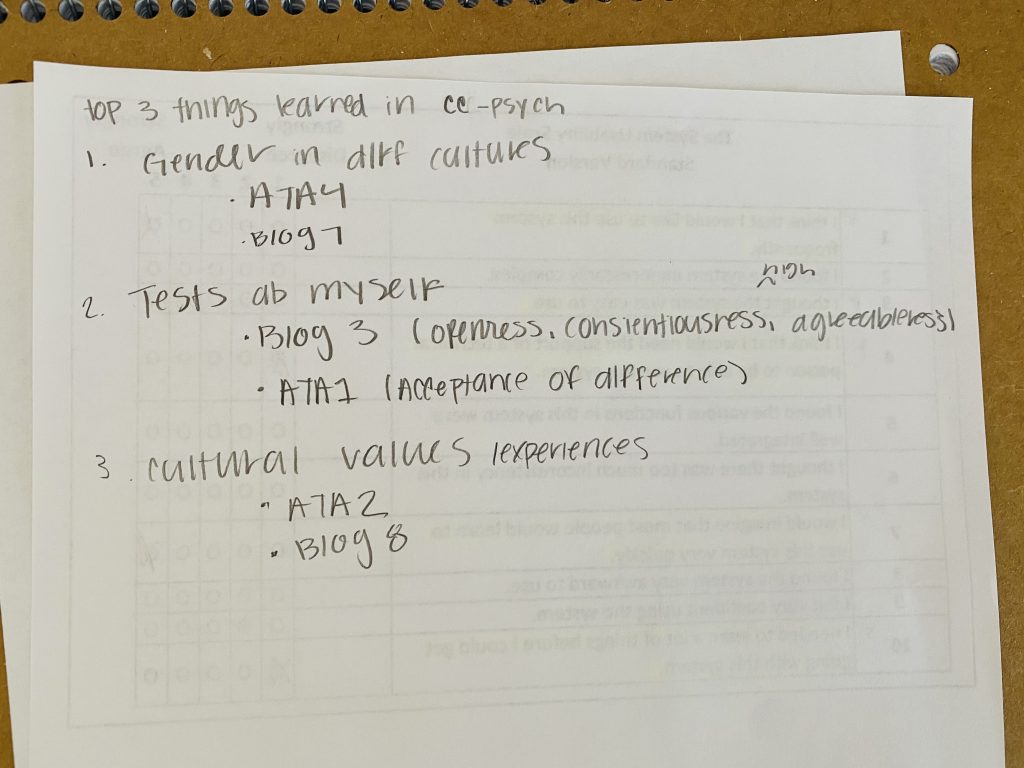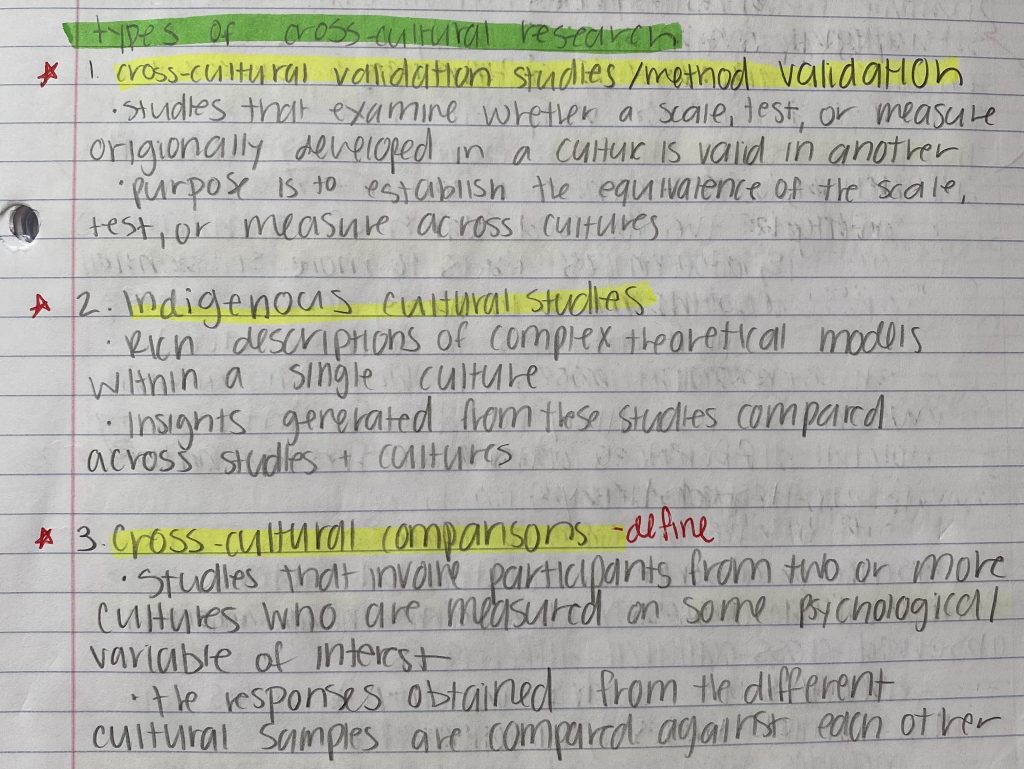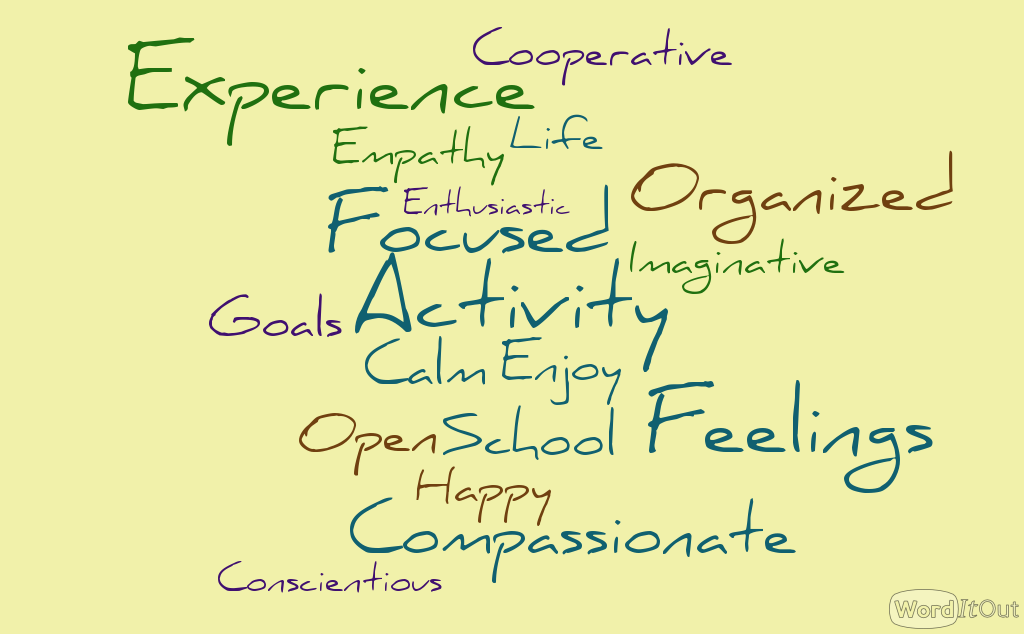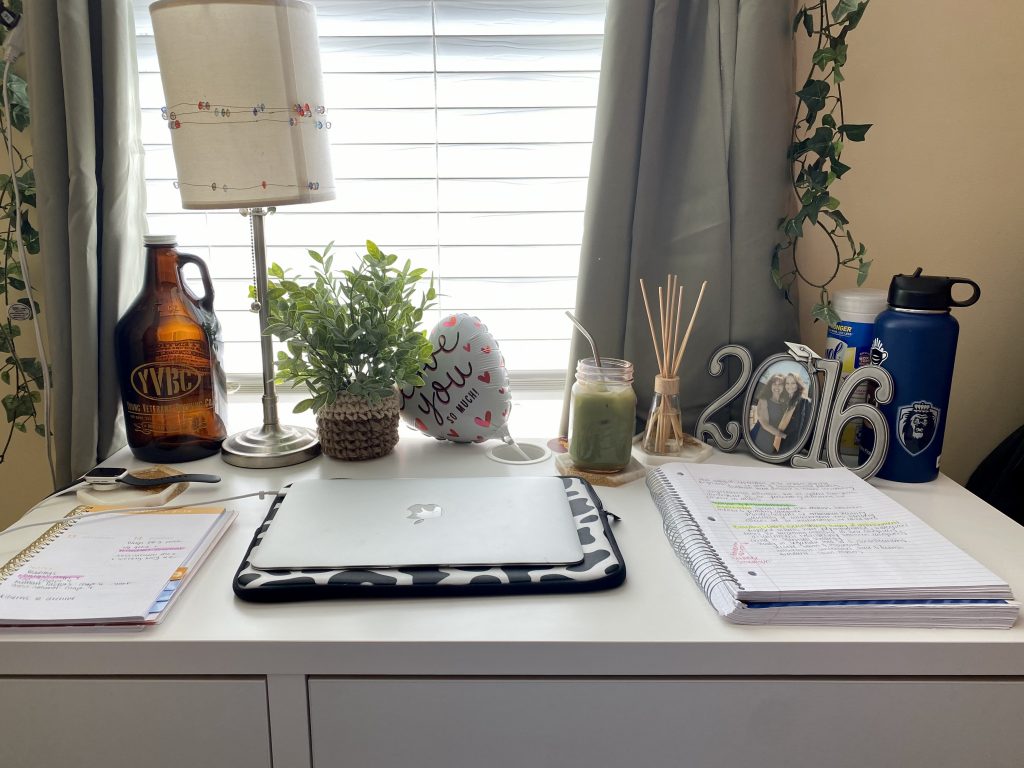Blog 10:
As the semester comes to an end, I look back at where I started. I remember when I was first singing up for classes and why I chose each one. I wrote in Blog 1 that I chose this class because I wanted to learn more about myself and gain knowledge that could help me in my future work of clinical psychology. I would agree I have achieved both. In fact, I even wrote in Blog 9 about how I’ve learned about myself. Topics that I can utilize in my future work include enculturation, culture & developmental processes, self & identity, cognition, emotion, and culture & psychological disorders. Also in Blog 1 I noted that I expected to learn about research and theories. Much of the textbook included research data from experiments and other studies. Theories were included in majority of the chapters as well. I enjoyed this class and the material we learned. One thing I believe would have emphasized my knowledge even more is if I was able to take this class in person. It can sometimes be difficult to empathize with others over the internet. None the less, my attitude toward cross-cultural psychology remains optimistic. I hope I can learn even more during in the future during grad school.
Academic Growth:

https://images.app.goo.gl/NApRq4ar9JXzemA18
I chose this image because Cross-Cultural Psychology is a class I believe will help me obtain success in my future work. Topics I have learned helped to gain a better understanding and backgrounds of different cultures. This is important for me to be aware of not only in a professional field but in my personal life as well.
Blog 9:
As reviewing the contents of my e-Portfolio, I would like to emphasize a few things I have learned along with connections I have made thus far in class. First, I want to start off with what I have learned about myself. In Blog 3, I took an NEO Inventory Personality Test. I scored high in openness, conscientiousness, and agreeableness. In ATA1, I identified with the stage “Acceptance of Difference” in intercultural sensitivity. I believe it is important to learn about yourself to find where you have room to grow. This was also emphasized when I took Positive Psychology and took a similar personality test. Positive Psychology taught me instead of asking “what’s wrong” and how to fix it, I learned “what’s right” and how to emphasize my strengths. Second, I researched how cultures portray gender differences. For example, in ATA4, I compared North American and Chinese cultures by the way they depict gender differences in their advertising. Both had clear emphasis of who they were targeting, however, different methods for doing so. In Blog 7, I investigate the North American culture in media by how they portray gender norms in classic Disney movies. Third, I learned how different cultures express their values and experiences. This started in ATA2 when I read Robert Kohls’s 13 values which he believed all Americans held. This was written to inform outsiders of what American’s were like before they visited. Then in Blog 8 I learned about cultural display rules. These “rules” are presented at birth and children learn how/when to express emotions. I compared American and Japanese cultures. Overall, this class has opened my eyes to what other cultures are like.
Organizational Process:

Above is my “process” of picking out my top three things I have learned about in Cross-Cultural Psychology. I went over and reviewed my ePortfolio so far while jotting down some notes. I found that the three topics came to me fairly easy then I found connections. My writing is messy but that is because I imagine my process as a “word dump”, writing down whatever came to me at the time. However, writing down my thoughts helps to keep them organized.
Blog 8:
While emotions are a universal experience, many cultures portray and define them differently. From my experience, the American culture tends to display and modify expressions by amplification. This meaning expressing more than actually felt. This may be because America values individualism and being different. I enjoy making it aware how I feel, this way people can use my emotions as context clues and help evaluate my opinions. When I was in high school, I worked at a family owned sushi restaurant. Most everyone who I worked with was Japanese. I noticed they tended to modify their expressions by deamplification. If someone in their family was upset they tried to hide it. I also realized when they did express emotion, they were displayed through their eyes. At first this was very different to me, however, over the years as I continued to work there I noticed it much less. Now, with the help of this class, I learned this was because of cultural display rules. In other words, different cultures have set “rules” of how and when to display emotions. This starts as soon as a child is born. My expectations have changed for other cultures as I have become aware many cultures do things differently. Expressing emotions is only one example.
Which Michael Scott are you today?

I chose this image to represent how American cultures represent emotion. According to cultural display rules and variations, Western cultures tend to represent emotions using the eyebrow and mouth area. There are many examples in this photo where those regions are used.
Blog 7:
Disney’s Beauty and the Beast has continuously challenged gender norms. In the first animated film, Belle represents the first feminist princess. She is looked at as “weird” by the village folk for wanting to learn and read. Back then, women were meant to rely on men and spend their time catering to them. She continues to act as a role model and positive influence in the later 2017 version by teaching a young girl how to read. Belle has always influenced people watching to disregard what others think. Other fairy tales represent old school norms, keeping a distinction between men and women’s roles. For example, women tend to play a “damsel in distress” role where only a man can save her. Disney movies that portray this idea include Snow White, Cinderella, and Rapunzel. However, the latest Beauty and the Beast film continues to challenge gender norms by featuring a first “exclusively gay moment” with one of the characters, LeFou. I enjoy seeing Disney advance and portray more modern ideas.
Another Modern Disney Movie:

I chose this image to represent another “modernized” Disney movie, Princess and the Frog. I enjoyed this movie a lot, it not only challenges gender norms but cultural norms as well. The main character, Tiana, becomes the first black princess. She challenges norms by being an independent women of color and building her career all by herself. This movie is a start with Disney moving away from older norms represented in previous films.
Blog 6:
Self-Determination theory helps explains that people from all around the world, people in different cultures, continue to share three basic needs: Autonomy, Competence, and Relatedness. Autonomy relates to when we do things in full heartedness or self endorsed. Competence relates to a level of mastery for things we feel are important. Relatedness is about feeling connected with others. To fulfill my need for autonomy I engage in activities that relate to my values or beliefs. For example, I value adventure so I enjoy going hiking. My competence is fulfilled when I get good grades or understand class material. My relatedness is fulfilled when I work in customer service. I enjoy talking and learning about other people. All together these are my specific ways I meet the three needs described in Self-Determination Theory.
Autonomy example:

Above is a picture I took when I went on a hike with some friends. This activity aligned with my values and I enjoyed the fun trip. My autonomy was fulfilled here.
Blog 5:
Our assigned readings for this week went over the topics of independent and interdependent construals of self. Independent construals of self include when you view yourself separate from others. Interdependent construals of self include when you view yourself as connected with others. I wrote 10 “I am” sentences down and then assigned them to either category. I had 5 independent sentences which included “I am intelligent. I am happy. I am organized. I am healthy. I am a good person.” These refer to my internal attributes. I also had 5 interdependent sentences which included “I am helpful. I am friendly. I am respectful to others. I am caring. I am generous.” These refer more to my relationship with others. With a clear 50/50 of my choice of sentences, I am unsure if I personally identify with more independent or interdependent construals. I believe it is important to be mindful of yourself in everyday life, however, I enjoy being a good friend and helping others. I work in the service industry which is where I apply these traits daily. This is an exercise I can continue to do in the future to see if I eventually identify with one more than the other.
Service Industry Meme:

https://www.pinterest.com/pin/685954586971086465/
I chose this meme to represent this assignment because most of my interdependent traits come from and are reinforced by working in the service industry. However, there are days where I have to focus on myself or use my internal attributes in order to keep a positive attitude through a rough day.
Blog 4:
This week’s blog I will be reflecting on our first exam! Typically, the first exam always causes the most anxiety for me. I make sure to take my time studying different resources for the first exam to get a feel for what is used most with creating exam questions. I usually find the book is most useful. For each chapter I start by taking notes from the book and then using the powerpoint as more of a guide to make sure I have focused on everything important. I also read through or watch other resources provided such as videos. Once it gets closer to the exam, I will print out the study guide and make note/highlight what items are on it in my notes. Going into the night before the exam and morning of, I go back through the book. This strategy helped me earn a 100 on my first exam. By reviewing my test results, it was proven I used the correct study format and will continue to do so for the rest of the semester. Given this feedback, I will stay motivated to continue to strive for excellence on other exams.
Using the Study Guide:

Above is an example of what my notes look like after I go through the study guide and make note/highlight certain terms. I usually use a red pen to mark little stars for important items and I also add notes or “hints” as what part of the item to study i.e Define the term.
Blog 3:
After taking the NEO Inventory personality test I learned how my personality can be described. This personality test uses the Big 5, or OCEAN model, to compare responses. To start with Openness, I scored high. I believe this fits into my personality because I like to try new foods and activities. I enjoy traveling as well. For Conscientiousness, I scored high. This is a perfect way to describe my personality because I am usually planning things in advance and my room/study supplies is well-organized. For Extraversion, I scored average. I agree with this because I never know if I should categorize myself as an introvert or an extrovert. I enjoy the company of my friends, however, when it comes to school and work I enjoy completing tasks on my own with little distraction. I also appreciate alone time. For Agreeableness, I scored high. I believe this fits into my personality well because I enjoy when my friends come to me for advice. I am compassionate and empathize well. Also, when someone disagrees with me I tend to avoid conflict. For Neuroticism, I scored average. I agree with this scoring because compared to my friends, I am usually the calmest in difficult situations. This could be because I tend to bottle up my own feelings. Sometimes they can explode, but I am generally calm.
Adjectives Related to Me:

Above is an image I created with adjectives that were brought to my attention after completing the NEO inventory personality test. I learned what my personality focuses on and what I am like compared to others. I feel confident that my personality reflects who I am/who I want to be in life.
Blog 2:
Growing up my grandparents and parents were always excited for me to go off to college. I excelled in elementary, middle, and high school. They knew I could survive. However, they made it seem like I had no choice. I remember my first job as a waitress at a local restaurant, my grandmother had made a comment about how that wasn’t a real job and I needed to focus on apply to colleges. At that age I didn’t mind continuing my education, I enjoyed learning. However, I also believe I would be fine if I didn’t go. I originally went to make my family proud. While continuing my career as a waitress, I changed my mind. I realized I deserved better than customer service. I wanted a job where I was respected and could display my hard work. Luckily, I had the resources and support that allowed me to transfer from community college to a university. With the help of my family and ODU I will soon graduate with a bachelors degree.
Where the Magic Happens:

Above is a picture of my current workspace. With COVID-19 causing all classes to go virtual, I needed motivation and a space at home that would allow me to get all of my work done. I filled my desk with items that make me happy and content. I have many items that were gifted to me from my loved ones, and a picture of my mother and I from high school graduation. I am reminded of how far I’ve come and what keeps me going.
Blog 1:
After looking over the course syllabus and reading the course description/objectives I have a better understanding of what I will be learning in this class. I expect to learn about myself and which cultures I align with. Other expectations include learning how psychologists conduct research across different cultures, the best ways to compare different cultures, and I also expect to learn how to apply psychological theories cross-culturally. After taking this class I hope to be more confident with my knowledge and ability to interact with other cultures. I hope to be able to empathize with other cultures better and apply these skills to my future work/education in clinical psychology. To ensure course success I will use maximum potential while completing all work and make sure I fully understand each objective before moving on to the next.
Culture:

https://qz.com/1324334/memes-around-the-world-the-worlds-biggest-meme-is-the-word-meme-itself/
I chose this meme in relation to Chapter 1: An Introduction to Culture and Psychology. We learned what specifically is culture, and what is not. For example, language and ethinicity are two groups that have culture. Meanwhile, personality and popular culture are two constructs that do not. Therefore the answer to “Is this culture?” would be no. Meme culture does not classify as a real culture.